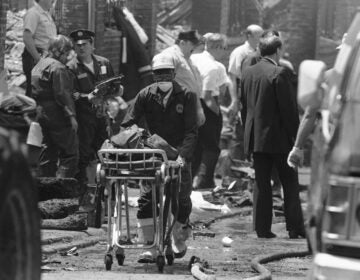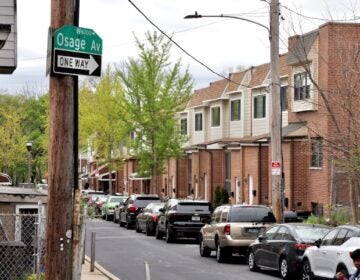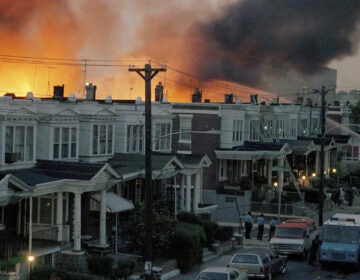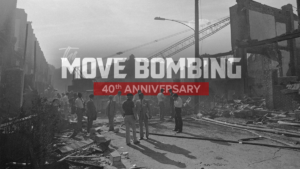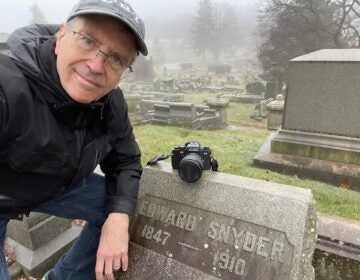MOVE at 40: ‘You don’t have to drop a bomb,’ helicopter pilot warned city in lead-up to deadly Philly attack
Exclusive: WHYY News' Tom MacDonald uncovers new details from the helicopter pilot who flew above the MOVE compound in 1985
Listen 5:45From Philly and the Pa. suburbs to South Jersey and Delaware, what would you like WHYY News to cover? Let us know!
It is a moment frozen in Philadelphia history.
The city’s decision to bomb a rowhouse in West Philadelphia resulted in death and devastation — 11 people died, including five children, and 61 homes were decimated from the resulting fire.
In the months after the bombing, the MOVE Commission determined city leaders, including then-Mayor Wilson Goode, were “grossly negligent” and called the plan to drop the bomb “reckless, ill-conceived, and hastily approved.”
But before dropping the bomb, city leaders were warned by a private helicopter pilot they enlisted to perform a surveillance flight over the house and the bunker constructed on the roof.
“I said, ‘The bunker’s no threat. There’s nobody in it. It’s just a bunch of rows of sandbags with a little gas can. There’s nobody in it. So, you don’t have to drop a bomb on that,’” pilot Mark Ciccone told WHYY News in an exclusive interview. “There’s nobody in it. It’s not a threat.”
This is the story of how Ciccone nearly flew police on that fateful bombing mission, with insights from others who were on the scene when Philadelphia became the first city to drop a bomb on itself.
The bunker
On May 13, 1985, Philadelphia police were given two orders.
First, arrest four members of MOVE, a group that emerged in the ‘70s as a back-to-nature movement but transformed into a Black liberation group that later sparked controversy and tension with law enforcement.
The second order was to remove children living at the MOVE residence on Osage Avenue.
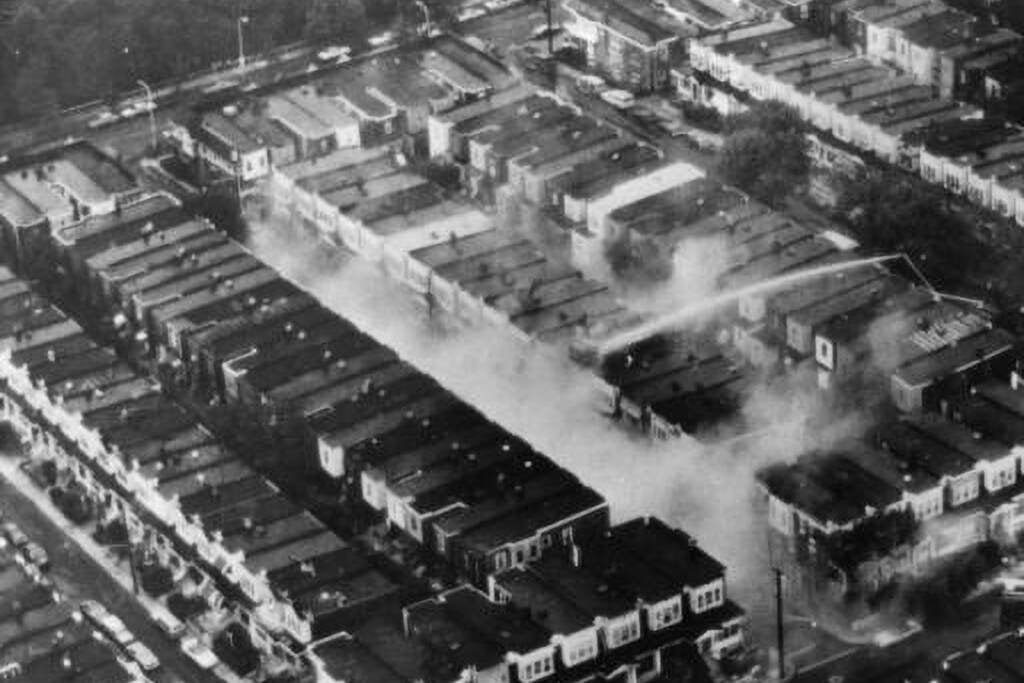
As they made plans to carry out those orders, police leaders were concerned about the strength of MOVE’s defenses, particularly a bunker built on top of the home. The bunker might give MOVE a tactical advantage and the ability to fire on officers at will, they said.
At one point, officials tried to figure out how to use a crane to remove the rooftop bunker.
Greg Sambor, police commissioner at the time, testified during the Philadelphia Special Investigation Commission, more commonly known as the MOVE Commission, that the action was discussed for about two hours.
“We were told … that it could not be done in any way other than a frontal assault and by a mechanical operation, not by swinging a ball or anything,” he said. “There was no way in which the safety of the operator could be guaranteed.”
Sambor said they determined there was only one entry point to the house they could use.
“A frontal assault would have been prohibitive, a rear assault was prohibitive, coming in through the lateral entry of the buildings had already proved to be ineffective. That left us only one recourse and that was — if we were to get any control of the situation in any reasonable amount of time — it would have to go through the roof.”
Devising a rooftop entry, police planners then turned their focus on the bunker, which they believed would have to be removed in order to safely enter the home.
‘You don’t have to drop a bomb on that’
Police decided to scout the bunker via the air by using a traffic service helicopter that usually flew to monitor traffic for TV and radio stations in the city.
Pilot Mark Ciccone flew for a traffic service known at that time as Sunoco Traffic Update. He was aware of the planning against MOVE because of a close relationship with police.
“We were advised of what was going on because I had a highway trooper on board at all times [during traffic reporting], because in those days Philadelphia didn’t have their own helicopters,” he said.

As a former military pilot who flew combat missions in Vietnam, Ciccone was called in to conduct a surveillance flight on the day of the MOVE confrontation. He was asked to fly over 6221 Osage Ave. to do reconnaissance for police planners. He did the first pass at a speed of almost 150 miles per hour.
“The first thing I did was a high-speed run. So, I had that Jet Ranger going as fast as it probably could possibly go, maybe 126-27 knots,” he said. “Just feet off the rooftops because I didn’t want to give them any chance … we didn’t want to give them any chance to say, ‘Oh, here comes a helicopter.’ No chance to fire at me, which they did anyway, but they didn’t have any chance of hitting me. So, that was a low, low-level pass, and I had the helicopter turned up on its side and I was looking right down that bunker as we flew over.”
Ciccone knew about the plan to use an “entry device,” or a satchel bomb, as it was referred to by those who built the device. He was experienced using them while in combat. After looking at the bunker, he told police using explosives was unnecessary.
“I said the bunker’s no threat. There’s nobody in it. It’s just a bunch of rows of sandbags with a little gas can. There’s nobody in it. So, you don’t have to drop a bomb on that,” he said. “It’s totally unnecessary … so don’t do it. But they felt otherwise, so they wanted that bunker or blown out.”
But why was a civilian helicopter being used for the surveillance effort? Ciccone said weather kept the Pennsylvania State Police from flying down to the city.
“It was a drizzly day, gray day, light rain, and the state police, who were tasked to drop the bomb, couldn’t get down from Reading, which was their home base,” he said.
The satchel charge
Even though he was against the move, the decision was made to move forward with the bomb, and Ciccone said he flew up to the police academy in Northeast Philadelphia to pick it up.
“The satchel charge, this is what we called it in Vietnam. A civilian would think it was a bag with a handle on it. It doesn’t look like a bomb that a typical person would think comes out of an aircraft,” he said. “It was a satchel charge used extensively by the Viet Cong in the Vietnam War. We didn’t use them much at all. We had more sophisticated stuff. But that’s what it was. It was a bomb in a bag. It was only, say 25 pounds, 30 pounds, and easily handled by one person.”
Ciccone picked up both the bomb and a police lieutenant who would drop it into his traffic helicopter. But just moments before they were to drop the bomb, they received a message over their radio from state police.
“They were on their way down. They made it. So, I flew over to a little schoolyard in West Philly,” he said. “We transferred the lieutenant and the bomb over to the state police. And then we continued to fly high cover for him, just keeping eyes on, you know, as I said they were shooting at everybody.”
The bomb was dropped at 5:27 p.m.

It contained a combination of C-4 military explosives and Tovex, a water-gel explosive that’s largely replaced dynamite in various applications. It’s known for being safer to manufacture, transport and store, and also has lower toxicity compared to dynamite.
Ciccone was high above the rooftop when the bomb hit.
“It wasn’t a spectacular explosion,” he recalled. “It just blew. In other words, just everything blew apart on the thing and then that [gas] can caught fire.”
Hidden viewpoint across the street
As police prepared to drop the bomb, photojournalist Pete Kane was hidden in a house across the street from the MOVE compound. He got into position after the neighborhood was evacuated Sunday night, May 12. He was there to see the firefight as police and members of MOVE shot at each other in the hours leading up to the bombing.
“Throughout the day, they estimated 10,000 rounds of bullets were fired from 10:06 that morning until I left the house at 8:30 Monday night,” Kane said. “Throughout the day, I went through tear gas being fired down on Osage Avenue. I was smelling the tear gas, bullets whizzing by.”
Before the bomb was dropped, the fire department used its high-capacity water jets known as deluge guns to try to knock out the bunker on the roof. Kane watched as the fruitless effort continued.
“What I was looking at was a fortress on the top of that house. I mean, the lumber they used was heavy lumber because the fire department hit that thing with everything they could with that deluge gun, that was thousands of pounds of pressure,” he said. “The only thing that came off of that bunker was the wrap that was around it, like a tarp that was on the outside of it.”
Kane said he remembers the feeling when the bomb struck the house, knowing that people were likely still inside.
“When the bomb was dropped, and when I went upstairs out the window, I saw the flames. I was saying to myself, ‘Please come out of the house.’ I knew they were there because throughout the night, I heard them. I heard Ramona, I heard a male person on the bullhorn. So, I knew that people may have still been in that house, ‘cause I never saw them come out. I never heard anything from the station that, ‘Hey, they came out, they’re out.’ So, in my mind, I knew people were still in 6221 Osage Ave.”
Once the bomb was dropped and the gasoline on the roof caught fire, the controversial decision was made to let the fire burn for several reasons. Police wanted to clear the roof of the bunker, and firefighters didn’t want to fight the fire out of fear of being shot at by MOVE members.
‘May 13th was a nightmare’
During the MOVE Commission hearings months later, fire expert Charles King offered commentary as the commission watched a video of the fire. He said the fire department’s deluge guns that had been used to target the bunker earlier in the day had very little effect at fighting the spreading flames.
“This is the deluge gun which is put in operation on 62nd and Osage. It’s not having an effect of putting the fire out. What it’s trying to do is to contain it,” he said. “The only way you can really stop a fire of this magnitude is to bring forces down Osage Ave.”

Fire department crews began conventionally fighting the fire at about 9:30 p.m., about four hours after it started. At that point, King said there was no stopping the flames as they spread down the block. When the firefighting effort started in earnest, 50 homes were in flames.
“Porches are a horrendous problem for firefighters,” Fire Commissioner William Richmond told the commission. “The fire will get under there and like a tunnel effect and just whip right down the porches. The second critical problem was the backs of both of these houses on the north side of Osage and the south side of Pine had extensions, which are frame extensions. And when the heat radiated across the alleyway, it didn’t take long to get those going.”
Photojournalist Pete Kane realized he was in danger and had to flee.
“I did not leave the house I was in ‘til 8:30 p.m., which was three hours after the fire got out of control,” he said. “My station told me to get out of there because I’m feeling the heat. I’m not not even a quarter-block away from where the MOVE house was. And by that time, all the homes on the north side of Osage Ave. was fully engulfed in flames. ”
By the morning of May 14, 61 homes were smoldering ruins. Eleven people were dead, including six children.
“May 13th was a nightmare,” Kane said. “It’s always going to be a nightmare for me and the people I worked with.”

Get daily updates from WHYY News!
WHYY is your source for fact-based, in-depth journalism and information. As a nonprofit organization, we rely on financial support from readers like you. Please give today.



